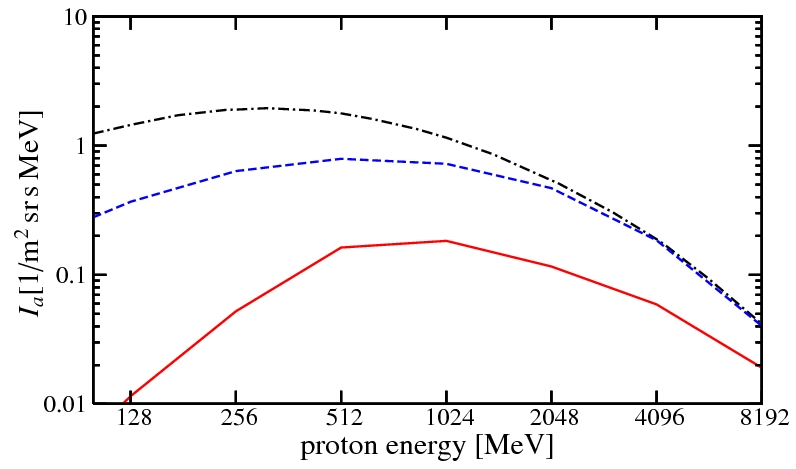Daily Image
21-11-2008The protection of Earth-like exoplanets against galactic cosmic rays
| Submitter: | Jean-Mathias Griessmeier |
| Description: | Space is full of them: Galactic cosmic rays, which continuously bombard our planet. Luckily for us, the Earth is shielded by two protective layers, namely its magnetosphere and its atmosphere. But what happens for a different planet, for example a planet without a strong magnetic field? It is believed that exoplanets which are very close to their host stars cannot have strong magnetic fields. Does this modify the influx of galactic cosmic rays to a planet in a close-in habitable zone, e.g. a planet at 0.2 AU from a 0.5 solar mass star? Yes, it does! We have run a test particle simulation with approximately seven million particles per energy. The image above shows the resulting energy spectrum: The top line shows the energy spectrum outside the planetary magnetosphere. The bottom line shows the particles that make it through the Earth's magnetosphere, illustrating that our magnetosphere indeed is an efficient shield. The middle line shows the same, but for a weakly magnetized exoplanet. It can be seen that the exoplanet is subject much higher cosmic ray fluxes than the Earth. For particle energies below 200 MeV, the cosmic ray flux to the exoplanet is up to one order of magnitude higher than on Earth, and for energies above 2 GeV magnetospheric shielding is negligible for the exoplanet case. However, so far it was not quite clear which effect was really responsible for the high particle flux to the exoplanet. Two main effects were thought to contribute to the weak shielding of such an exoplanet: (a) Its weak magnetic moment. For a close-in planet, the planetary magnetic moment is strongly reduced by tidal locking. Therefore, such a close-in extrasolar planet is not protected by an extended magnetosphere. (b) Its small orbital distance, which exposes the planet to a much denser stellar wind than that prevailing at larger orbital distances. This dense stellar wind compresses the magnetosphere, which can further reduce the shielding efficiency against GCRs. We analyze and compared the effects of (a) and (b) and found that the stellar wind variation with orbital distance has little influence on the cosmic ray shielding. Instead, the weak shielding of M star planets can be attributed to their small magnetic moment. This result is published in a paper in Icarus: "On the protection of extrasolar Earth-like planets around K/M stars against galactic cosmic rays" by J.-M. Grie▀meier, A. Stadelmann, J. L. Grenfell, H. Lammer, U. Motschmann. http://dx.doi.org/10.1016/j.icarus.2008.09.015 |
| Copyright: | Jean-Mathias Griessmeier |
| Tweet |  |
